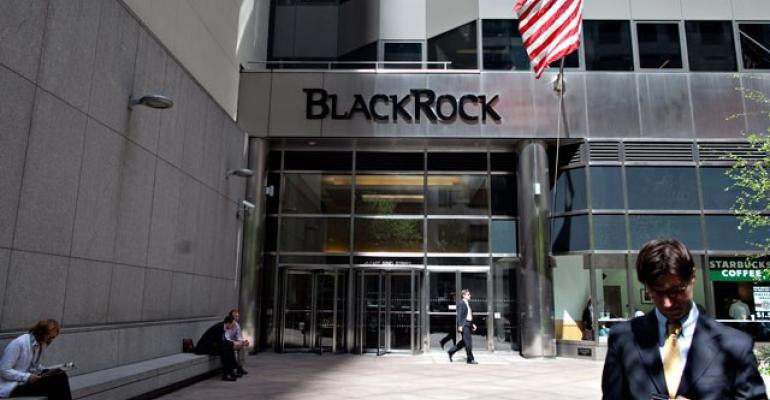By Carolina Wilson
(Bloomberg) --A new smart beta trend is kicking off, but for once you won’t find BlackRock Inc. leading the pack.
The world’s biggest money manager, whose iShares exchange-traded funds are the gateway drug for many into the world of smart beta, is calling “too soon” on the latest version of these strategies, known as dynamic multifactor.
The term refers to funds that shuffle through factors like profitability and momentum, reading market signals to adjust their exposure rather than relying on investors to make the timing decisions.

BlackRock’s stance puts it at odds with firms like Pacific Investment Management Co. and OppenheimerFunds Inc., which are going all in on the trend. Oppenheimer is listing two dynamic multifactor funds today, tickers OMFL and OMFS, that apply filters such as quality and size to U.S. stocks. Pimco listed three of the funds in September.
What’s got the industry split is a simple question: Are investors ready for it? BlackRock says no.
“The average investor approaching the factor space is probably going to think we’re speaking Klingon,” said Ben Johnson, director of global ETF research at Morningstar Inc. “So when you go from single factor to multifactor, it’s almost like advanced Klingon.”
Market Beating
At its core, the premise of dynamic multifactor is relatively straightforward. It targets shares with characteristics shown to beat the market over time. What’s tricky is figuring out which factor is going to outperform when. That’s where the dynamic approach comes into play.
Pimco was the first to test the appetite for these strategies when it partnered with Research Affiliates LLC on three dynamic multifactor ETFs tracking U.S., international and emerging markets stocks. The funds, which are pegged to the RAFI Dynamic Multi-Factor indexes, have gathered between $20 and $30 million apiece.
While those aren’t blockbuster numbers, investors have on the whole shown interest in ETFs tracking more than one factor. They’ve piled $66.5 billion into U.S. funds following static and dynamic strategies, more than they’ve put into low volatility and momentum ETFs, according to data compiled by Bloomberg Intelligence.
“We’re trying to attack the same problem as Pimco,” said Mo Haghbin, Oppenheimer’s head of ETF product development. The firm’s new funds apply low volatility, momentum, quality, size and value screens to the Russell 1000 and Russell 2000 indexes. The ETFs then read “the economic environment and overall market conditions” to decide on the best mix of exposures, according to a company release.
‘Better Approach’
Alongside its dynamic multifactor ETFs, Oppenheimer is also listing six single factor funds today, tracking strategies like value, quality and size.
“Investors shouldn’t just hold a constant exposure to factors because there’s a cyclicality inherent to them,” said Haghbin, in a knock against static multifactor funds. “We think the better approach is making them respond to the environment we’re in.”
There are some prominent voices who agree.
Research Affiliate’s CEO Rob Arnott, a smart beta pioneer, has said that investors are prone to performance chasing, which can lure them into buying factors like low volatility after they’ve become dangerously expensive.
“People are picking things that have had the best three- to five-year returns, and that destroys your returns,” Chris Brightman, chief investment officer at Research Affiliates, said in an interview on Sept. 6.
To be sure, BlackRock isn’t so much against the strategy as doubtful that the timing is right. “Investors don’t fully understand how multifactor works,” said Rob Nestor, head of iShares smart beta at BlackRock. “One of the real hurdles for multifactor is that people just don’t get how they fit in.” To that end, the firm is going to spend 2018 trying to lure investors to its single factor ETFs, he said.
Sales Push
BlackRock intends to double its sales team for single factor strategies in the first half of 2018, according to Nestor. It also plans to roll out smart beta funds covering fixed-income and commodities in the next 12 to 18 months. But for now, it’s leaving dynamic multifactor alone.
Among the firm’s biggest offerings in the single factor space are the $17.1 billion iShares Select Dividend ETF, ticker DVY, and the iShares Edge MSCI Min Vol USA ETF, symbol USMV, with $14.4 billion in assets. Neither fund is beating the S&P 500 Index this year, according to data compiled by Bloomberg.
But pushing single factor over multifactor is just the first step in a long game for BlackRock, Nestor said. After all, this is the same firm whose executives see slashing fees on basic products as a way to get investors to eventually turn to something more complex and expensive.
“We see it as an evolution,” said Nestor. “It starts largely with single factors and evolves to multifactor.”
--With assistance from Sarah Ponczek.To contact the reporter on this story: Carolina Wilson in New York City at [email protected] To contact the editors responsible for this story: Arie Shapira at [email protected] Yakob Peterseil, Eric J. Weiner





